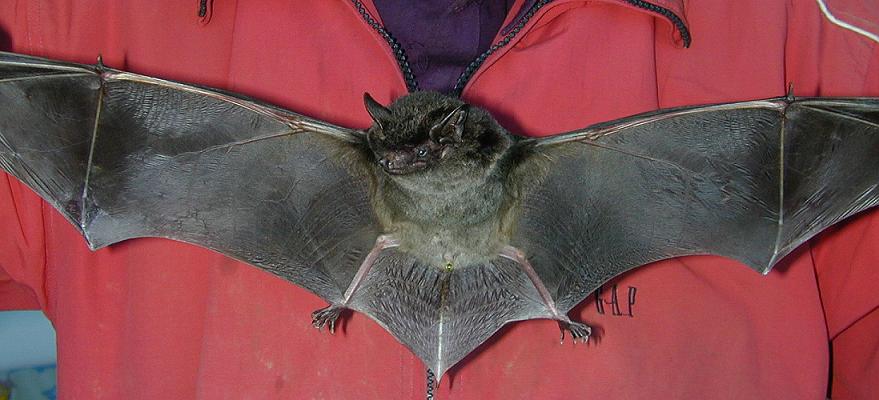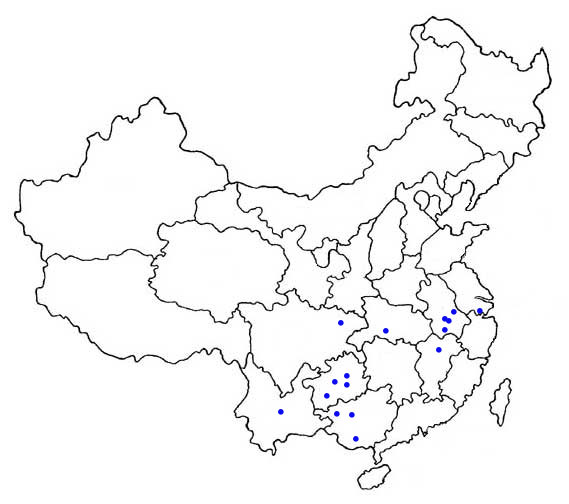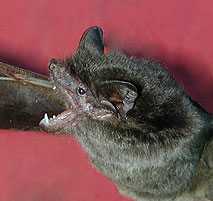Ia io
Great evening bat
Morphological description Life history Distribution Habitat Roost sites and roosting patterns Emergence and flight pattern Foraging behaviour Echolocation calls Status and protection

Morphological Description
· Dorsal fur is grey-black. Ventral fur is browner.
· It is one of the largest vespertilionid bats. Average forearm length is 74.1mm (range 70.9-77.3mm) (Bates & Harrison, 1997).
· The face is naked. The ears are broad.
Body mass 49-63 g in India (Thabah et al. 2007).
· The species is phylogenetically close to Scotomanes, and is placed in the tribe Nycticeiini, not the Pipistrellini as previously thought (Thabah et al. 2007). .
Life history
· 83% of females collected on 25 April in Sichuan were pregnant, each with one embryo (Pen et al. 1962).
Distribution
Found from north-east India, Nepal, southern China, northern Thailand, Laos PDR and northern Vietnam (Bats & Harrison 1997). The Chinese distribution is shown by dots on the map (as given by Zhang et al. (1997).

Habitat
· They were found in India at an altitude of 1600 metres (from Bates & Harrison 1997). Pen et al. (1962) collected 55 bats from a cave at 1700m in Sichuan.
Roost sites and roosting behaviour
· Roosts in caves.
Emergence and flight pattern
· Ia io has a high wing loading (15.4 Nm -2 ), average aspect ratio (6.9) and a high tip shape index (1.1), features associated with fast and efficient flight (Thabah et al. 2007).
Foraging behaviour
· This is a carnivorous bat and feds extensively on birds. It evolved this remarkable feeding habit independently of Nyctalus lasiopterus, which seems to specialise in capturing migrating birds in the air (Ibanez et al. 2001). In India (Meghalaya) the diet comprises mainly Coleoptera and birds, although Lepidoptera and traces of Diptera, Orthoptera and Hemiptera were also found (Thabah et al. 2007). In China, (Guizhou Province) bats were captured in early November, and fresh droppings were also collected from underneath the roost. Bird feathers comprised 82% of the bats' droppings by volume (Thabah et al. 2007).
Echolocation calls
Ia io emits relatively low frequency echolocation calls and sometimes produces two-toned calls, a characteristic of species that echolocate distant targets. A waveform and spectrogram from a bat recorded in India below (Thabah et al. 2007).
.
The table below shows call characteristics from two-toned calls recorded from hand-released bats in India (Thabah et al. 2007).
Call parameters
|
Higher Tone |
Lower tone |
Highest energy (kHz) |
27.6 ± 1.5
|
24.8 ± 1.5
|
Start Frequency (kHz) |
34.9 ± 5.9
|
38.6 ± 2.8
|
End Frequency (kHz) |
21.9 ± 1.8
|
18.0 ± 1.1
|
Duration (ms) |
2.4 ± 0.5
|
3.8 ± 0.6
|
Pulse Interval (ms) |
65 ± 20.5 |
93 ± 9.3 |
Status and protection
· There is no estimation of population size in China for this species.
· Great evening bats are at LR/nt, assessed by the Red List of Threatened Species (IUCN, 2006) and are not listed in the Law of the People's Republic of China on the Protection of Wildlife in 1989. They are quite widely distributed, but little is really known about the status of this fascinating bat.
· Caves should be protected as their habitats.
